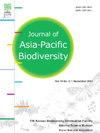Do wildfires impact community structure and diversity of beetles (Coleoptera) in northern Mongolian forests?: An investigation in Khentey Mountains
IF 0.7
Q4 BIODIVERSITY CONSERVATION
引用次数: 0
Abstract
Forest fires are part of taiga ecosystem dynamics in northern Mongolia. We studied beetle diversity and community structure in 98 plots at five sites in different forest types (light taiga, mixed taiga, dark taiga, floodplain forest) and under different fire regimes. Each plot included five pitfall traps, one soil and litter sampling and recording of environmental variable measurements. We used Hill numbers, GLMM and RDA to evaluate the data. In total, we collected 2692 individuals of 130 species and 72 genera of beetles, mainly Carabidae, Staphylinidae, Silphidae, and Leidodidae, with Pterostichus eximius occurring in 60% of all plots. Forest fires had a significant effect on diversity and community structure of Coleoptera at the local level. However, in all data, the effects of site and forest type outweighed the influence of fire. An RDA explained 32% of the variation in community patterns with the effects of fire and environmental parameters. RDA1 scores differed significantly by fire regime, suggesting different species composition of post-fire communities. Hylobius abietis, Byrrhus pilula and Leiodes sp2 were identified as indicator species for fire plots. Protection of beetle refugia is critical for successful habitat recolonization, but is threatened by the post-fire salvage logging practices common in Mongolian forestry.
野火是否影响蒙古北部森林甲虫群落结构和多样性?:在肯泰山脉的调查
森林火灾是蒙古北部针叶林生态系统动态的一部分。研究了不同林分类型(轻针叶林、混交林、暗针叶林、洪泛平原林)和不同火灾条件下98个样地的甲虫多样性和群落结构。每个小区包括5个陷阱,1个土壤和凋落物取样和环境变量测量记录。我们使用Hill数、GLMM和RDA来评估数据。共采集到甲虫72属130种2692只,主要有甲甲科、棘甲科、银甲科和银甲科,其中近尾翼螨占所有样地的60%。森林火灾对鞘翅目昆虫的多样性和群落结构有显著的影响。然而,在所有数据中,地点和森林类型的影响超过了火灾的影响。RDA解释了32%的受火灾和环境参数影响的群落模式变化。RDA1得分在不同的火灾状态下差异显著,表明不同的物种组成不同。水蛭(Hylobius abietis)、水蛭(Byrrhus pilula)和水蛭(Leiodes sp2)是火灾样地的指示种。保护甲虫避难所对成功的栖息地再定居至关重要,但受到蒙古林业常见的火灾后救助采伐行为的威胁。
本文章由计算机程序翻译,如有差异,请以英文原文为准。
求助全文
约1分钟内获得全文
求助全文
来源期刊

Journal of Asia-Pacific Biodiversity
Agricultural and Biological Sciences-Insect Science
CiteScore
1.70
自引率
12.50%
发文量
94
审稿时长
27 days
期刊介绍:
The Journal of Asia-Pacific Biodiversity (previous title was Journal of Korean Nature) is an official journal of National Science Museum of Korea (NSMK) and Korea National Arboretum (KNA). The scope of journal is wide and multidisciplinary that publishes original research papers, review articles, as well as conceptual, technical and methodological papers on all aspects of biological diversity-its description, analysis and conservation, and its application by humankind. This wide and multidisciplinary journal aims to provide both scientists and practitioners in conservation theory, policy and management with comprehensive and applicable information. However, papers should not be submitted that deal with microorganisms, except in invited paper. Articles that are focused on the social and economical aspects of biodiversity will be normally not accepted.
 求助内容:
求助内容: 应助结果提醒方式:
应助结果提醒方式:


